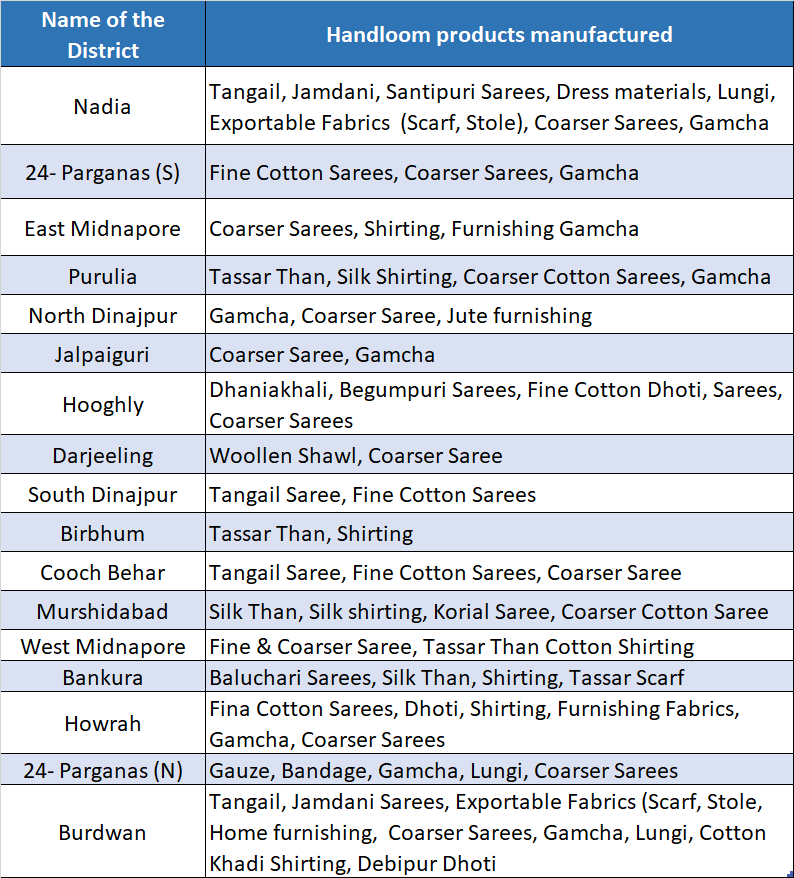This article is written by Mouli Mondal.
Table 1: District-wise handloom products manufacturing details
The main concerning factor is it is a labor-intensive industry where people still rely on age-old machinery. Further, the artisans do not undergo any formal training and the majority of them don’t have proper education, as a result, this sector has not undergone significant modernization.
In recent years, the handloom sector has faced stiff competition from the commercial manufacturing sector. However, the handloom sector is a heritage, and its products are proof of an age-old culture and tradition, which can’t be replaced. The government of India has tried to uplift the handloom sector through various schemes “Make in India” initiative and various incentive schemes have served as a plausible way to reinstate the glory days of the handloom sector.
2. Satya Narayan Bag, 2021, Study On West Bengal Handloom Industry, International Journal of Academic Management Science Research (IJAMSR), ISSN: 2643-900X Vol. 5 Issue 6, June - 2021, Pages: 53-61.
3. Dr. Chittaranjan Das, 2017, Handloom Industry In West Bengal: A Study, IJSART - Volume 3 Issue 11, Pages: 55-58
The handloom sector of West Bengal is one of the largest decentralized, labor-intensive sectors, that is the torch bearer of centuries-old tradition and cultural heritage. The sector is less capital-intensive and mainly focuses on manual labor for material products that are eco-friendly. The West Bengal handloom sector is a very vibrant sector comprising of 6,31,447 (~1% of the West Bengal population) handloom and allied workers and 2,83,404 handlooms as of 2020.
The handloom sector in West Bengal is mainly located in rural and sub-rural regions of West Bengal spread over 17 districts as shown in table 1. The handloom sector of West Bengal contributes to 35.3% of the total saree production in India, also contributing 12 % of towel, napkin, duster, and gamcha production.
The handloom sector in West Bengal is mainly located in rural and sub-rural regions of West Bengal spread over 17 districts as shown in table 1. The handloom sector of West Bengal contributes to 35.3% of the total saree production in India, also contributing 12 % of towel, napkin, duster, and gamcha production.
Table 1: District-wise handloom products manufacturing details

Alongside producing fine-quality hand-woven fabrics, the West Bengal handloom sector carries a rich cultural history. The craft that exists today has withstood the test of time and has been passed down from one generation to another.
The main concerning factor is it is a labor-intensive industry where people still rely on age-old machinery. Further, the artisans do not undergo any formal training and the majority of them don’t have proper education, as a result, this sector has not undergone significant modernization.
In recent years, the handloom sector has faced stiff competition from the commercial manufacturing sector. However, the handloom sector is a heritage, and its products are proof of an age-old culture and tradition, which can’t be replaced. The government of India has tried to uplift the handloom sector through various schemes “Make in India” initiative and various incentive schemes have served as a plausible way to reinstate the glory days of the handloom sector.
1. Handloom Sector, 2022, http://handlooms.nic.in/assets/img/Statistics/2486.pdf (Government of India Data)
2. Satya Narayan Bag, 2021, Study On West Bengal Handloom Industry, International Journal of Academic Management Science Research (IJAMSR), ISSN: 2643-900X Vol. 5 Issue 6, June - 2021, Pages: 53-61.
3. Dr. Chittaranjan Das, 2017, Handloom Industry In West Bengal: A Study, IJSART - Volume 3 Issue 11, Pages: 55-58

